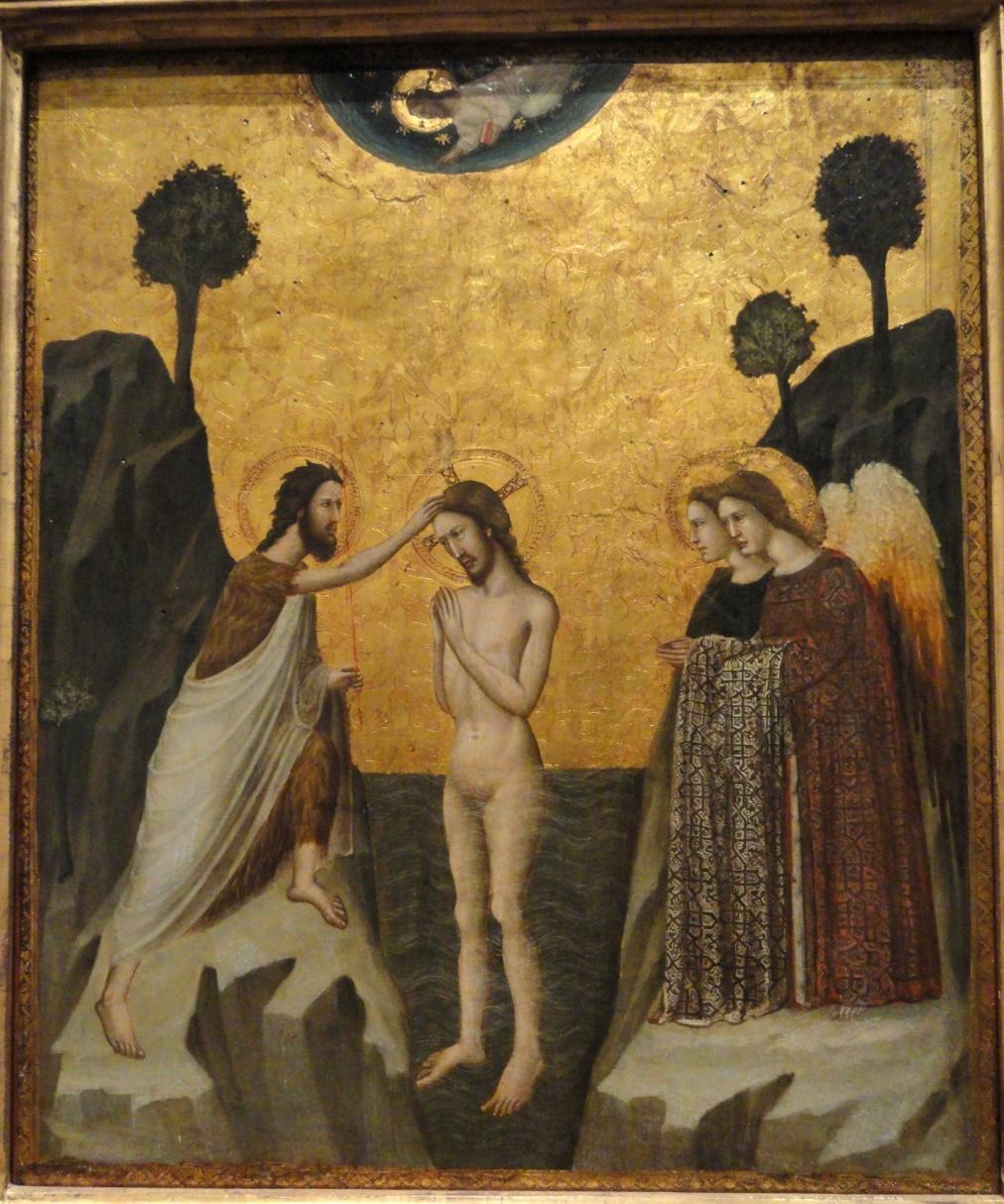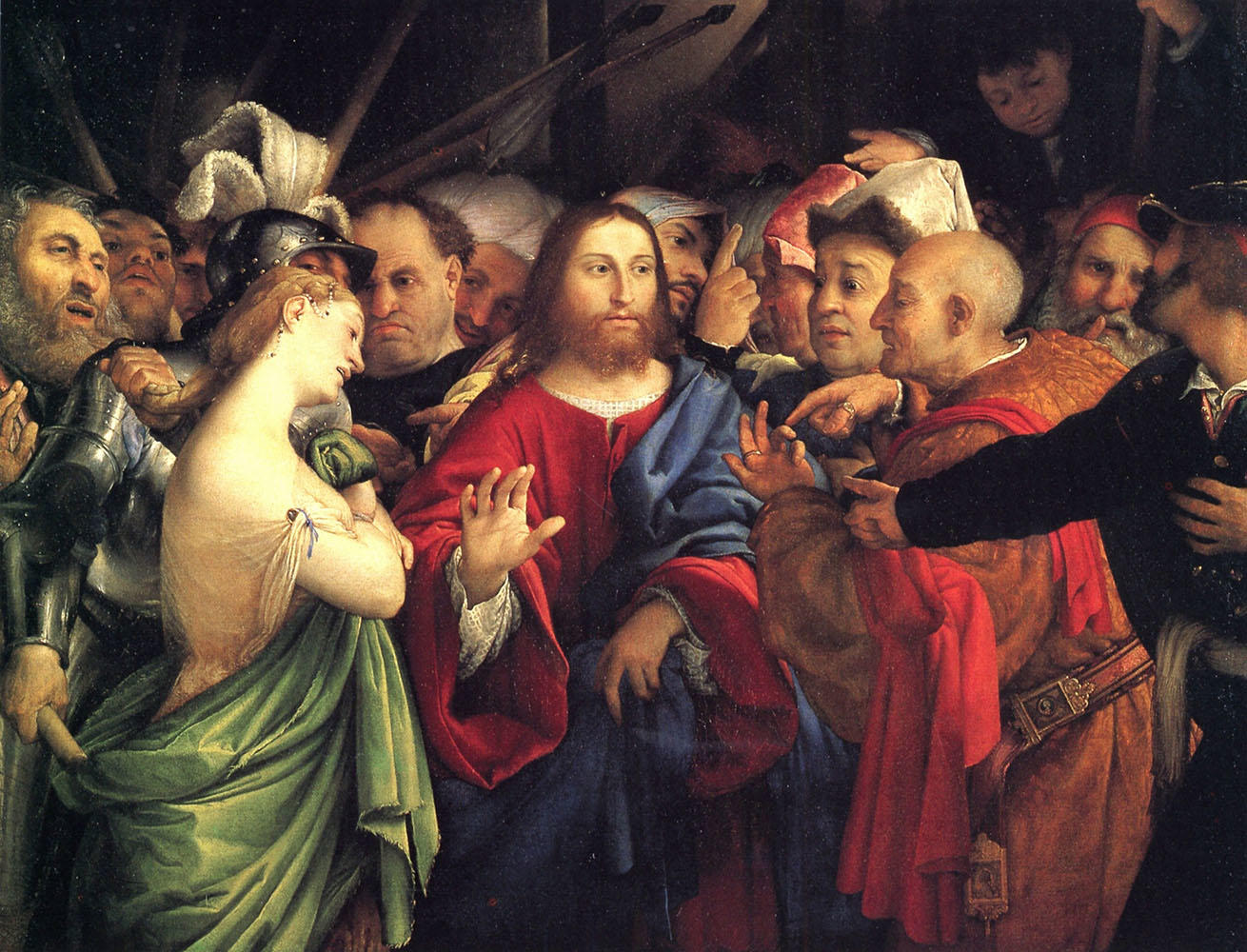

The two artworks representing the image of Christ I have chosen for my paper are (in the order of the pictures): (a) “The Baptism of Christ” by master of the Life of Saint John the Artist (National Gallery of Art, Washington), and (b) “Christ and the Adulteress” by Lorenzo Lotto (Louvre, Paris). I have chosen these two paintings because both of them had an emotional impact on me and because they are created by prominent artists, recognized all over the world, which contributes to the significance of the two works. I have seen one of them, “The Baptism of Christ,” in person at the National Gallery of Art, and its analysis will rely on the feelings I received while watching it.
The first painting, “The Baptism of Christ,” was created by an anonymous Italian artist, whose works were exclusively religious. Most probably created between 1330 and 1340, the painting depicts the process of Christ’s baptism, one of the most recognized and significant scenes in the world of Christianity. The painting is rather small for this kind of genre, its size is 40X41 cm. In the center of the painting, we can see the figure of Christ who is standing in the water, while St. John the Baptist is pouring the water on His head, thus performing the ceremony of baptism. On the right, there are two figures of angels who are ready to give Christ his clothes after he comes out of the water. Above them all, there is a figure of a Saint, who is reading the Holy Scriptures.
Monotonous in colors and relatively primitive in the scope of details, this painting still has a powerful message in it, which the viewers surely notice. The first thing that really stroke I was the uncovered body of Christ. I have never seen the figure of Christ presented naked before, and in this painting, where the artist shows Him this way, it is quite shocking to see. However, this nakedness looks surprisingly suitable and even adds to the general atmosphere.
Uncovered and unprotected, Christ looks rather vulnerable and fragile, a quality that would never be associated with such a powerful character as Christ. The depiction of His body is rather simplified, which is characteristic of the period and genre. However, I have noticed that the lower part of Christ’s body looks rather feminine if to analyzes the proportions of the human body. This also contributes to the vulnerability of the image, which, I suppose, is the central point in the painting’s Christology. There is certainly some tension in the air, and it makes the ceremony more meaningful. His hands joined in prayer, and his head bent on the side, Christ makes an impression of a humble and resigned person who realizes the importance and duties related to His baptism. This is exactly what one would expect from this scene, as baptism is Christ’s mature decision.
Another detail about this painting is the composition that also gives a certain effect. Specifically, I have noticed that there are mountains behind St. John the Baptist and the angels; in contrast, Christ is standing in the water, in the bosom of Nature, unsheltered and free at the same time. While all the other characters in the picture seem to be protected by “walls” of mountains, Christ is in the open water, which has no limits, both an atmospheric and symbolic detail.
The main color used in the painting is golden; this is a traditional color in icons, and it is supposed to make the painting more sacral for the viewers. It actually does so; besides the idea and emotion preserved in the painting, I also felt the value of the material part of the artwork, which probably contributed to the general greatness of the painting.
The second painting, “Christ and the Adulteress,” was created by another Italian, Lorenzo Lotto, approximately in 1550. The two centuries that separate the two paintings are very noticeable in the painting; the style, approach, and methods are totally different. The second painting is much bigger; its size is 125X99 cm. Like the first one, it shows a famous scene from the Bible, where Christ stops people from throwing stones at a woman who was caught in adultery.
In his painting, Lotti depicted a group of people with Christ in the center. As contrasted to “The Baptism of Christ,” this painting presents Christ in the setting of his routine among people whom he helped and taught. All the figures in the painting are very dynamic and expressive, trying to explain something or reach for Christ or the woman. Only the figure of Christ is rather static and calm. Christ radiates peace and understanding; it seems that He understands both sides. He does not take part because of His unconditional love for everyone in the picture. His gestures are very expressive; He stops people from arguing with His right arm and shows disapproval of their behavior by the right hand.
The whole picture shows Jesus as an element of order in the world of chaos, which, from my point of view, is the Christology shown by the artist. The colors of Christ’s clothes are the brightest in the painting, which helps him to stand out of the crowd; however, there are no other distinctive signs that can help the viewer to detect Him – Christ looks rather human-like. In my opinion, this shows that anyone can have wisdom and show love, just like Christ did.
The two paintings are contrasting because of the different approaches they used for depicting Christ, in respect of the composition, colors, and general presentation. While “The Baptism of Christ” shows Christ as an obeying and vulnerable character, “Christ and the Adulteress” depicts Him as a powerful and merciful character. Both pictures point to the human nature of Christ, the first one by means of anatomy and lack of protection, and the second by means of showing Christ in a trivial situation, with no distinctive signs of His holy nature.
To be honest, the first picture had a greater effect on me, maybe because of the fact that a secret sacred ceremony is depicted there. The first image of Christ is also rather unexpected, and the feeling of being unsheltered is very vivid. The second painting was also interesting, but mostly in terms of visual perception and “reading” the message of the artist, not in terms of dealing with feelings and emotions. I believe that each of them creates a different Christology in the minds of the viewers, but both of them are acceptable and valuable for Christians.